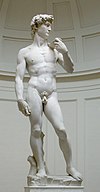Medieval Aesthetics: Renaissance, Classical Aesthetics, Aesthetic feeling, Modern Aesthetic
Medieval Aesthetics

Boethius teaching, manuscript of the Consolation of Philosophy, 1385
The aesthetics of the Middle Age incorporates the principles of Neoplatonism linking them to the theological model of Christianity. Consider then that in artistic creation is distilled dignity creative, comparable to the divine creation. Art is a means of transcendence to the intelligible. Symbolism of Plotinus is added the allegory, which is no longer regarded as mere figure of speech (rhetoric) but as a preferred means of correspondence with the ideas.
Important work expands on the concepts of proportion, and light in art.
Philosophers: Pseudo-Dionysius, Augustine of Hippo, Boethius, Thomas Aquinas
Renaissance

David of Michelangelo.
Secularization of art.
Naturalism.
Back to the visible representation. Sensationalism.
Leon Battista Alberti, De pictura (1435) notion of perspective, pictorial beauty in the composition just by the stroke (circonscriptio), art drawing, chiaroscuro ...
Marsilio Ficino (1433-1499)
Classical Aesthetics
Aesthetic rationalist

René Descartes
Descartes, Leibniz
Nicolas Boileau, Art poétique
Montesquieu
Aesthetic feeling
Charles Batteux
Abbé Jean-Baptiste Dubos (Voltaire) => literary criticism
Aesthetic empiricist
The book Philosophical Inquiry into the Origin of Our Ideas of the Sublime and Beautiful (1757) the Irish philosopher Burke (1729-1797) can be regarded as the empirical manifestation of the aesthetic philosophy We can add aesthetic Tests of Hume.
The classical aesthetic, inspired by the Banquet of Plato and finding one of its most accomplished expression in the poetics of Boileau, conceived not only aesthetic value, beauty, and its negative, the ugly. The fine was conceived in terms of harmony, symmetry, order and measure. The aesthetic empiricist add a second value positive aesthetics, the sublime. The sublime is a value characterized by disharmony, dissonance, excess, disorder, asymmetry. Where produced the beautiful feeling of serenity in the soul, the sublime produces such feelings of terror and violent passion (without pay in horror). The sublime art will find application in the more absolute the romance, will ignite the passion and excess in the human soul (the artistic genius, passionate love, the solitary ego or political revolution).
In classical aesthetics, the concept was good. We can talk about this as "intellectual art" or "aesthetic intellectualism. For example, in ancient times, music was put among the four sciences quadrivium. It was a science of harmony and measure, and St. Augustine describes in his "Treatise on Music.
Instead, the aesthetic empiricist sees the beautiful and sublime as inner feelings. These are performances that is the soul at the aesthetic experience. The handsome returns to a feeling of pleasure and calm, while the sublime refers to a feeling of pleasure mixed with pain, or an alternation of contradictory feelings. The taste is no longer an intellectual concept, but its printing and sensitive feeling, defined as the empiricist ideas in mind the truest and most vivid.
Anthony Ashley-Cooper (3rd Earl of Shaftesbury) (1671-1712). The unselfishness.
Objectivism
Modern Aesthetic
Kant: aesthetic judgment
Immanuel Kant (1724-1804)
.jpg/150px-Immanuel_Kant_(painted_portrait).jpg)
Trial
Gorgeous
Question of Romanticism
Questioning the nature of aesthetic feeling, Kant observed that for perception of the pleasant, everyone recognizes that this feeling has value only for himself, and it is not possible to challenge the pleasure felt by the other: "When I say that the canary is nice, I willingly suffer that I should resume and that reminds me that I must say only that it is pleasant to me." By this, he comes to think that "everyone has his particular taste.
The case of beauty is different, however, since it considers a good thing as: "I attribute to others the same satisfaction" and "I do not think only for me but for everybody, and I talk about beauty as if it was a quality of things (...) ". It thus shows that the fine is not the fun. The trial of the beautiful is not performed according to personal taste: "We can not say that each has its special taste."
Hegel's philosophy of art

Hegel
The Aesthetic is defined as the philosophy of the art and purpose of art is to express the truth. Aesthetics is the science of beauty as far as beauty is the artistic beauty that is to say, the beautiful book by the man and for man.
1) The Fair is the idea in a tangible form, the Absolute is given to intuition. Art is the objectification of consciousness by which it manifests itself. It is therefore an important moment in its history. The reflection on art is tied to the end of art in the sense that this is an overflow sensing element to the thoughts pure and free. The excess occurs in the religion and philosophy. For Hegel the worst productions of man is always superior to the most beautiful landscapes, because the artwork is the preferred means by which the human mind is realized.
2) History of Art is divided into three, according to the form and content of art:
symbolic art, oriental, sublime, where the shape exceeds the content;
classical art, Greek, beautiful, which is the balance of form and content;
Romantic art, Christian, truth, where the content is removed from the form.
3) The system of Fine Arts is divided into four major arts following space and time:
architecture (space)
sculpture (space)
painting (space)
music (time)
poetry (time)
Kierkegaard
Kierkegaard opposed Hegel.
History is myth.
Aesthetic stage.
Instant and sensuality (repressed by Christianity)
Science of Art: Kunstwissenschaft
.jpg/150px-Johann_Joachim_Winckelmann_(Raphael_Mengs_after_1755).jpg)
Portrait of Winckelmann, by Raphael Mengs, 1768.
In the nineteenth century formalizes Kunstwissenschaft or "science of art" around a historical approach to art, called historicism (around the principles of individuality and of evolution including through the work of the historian Jacob Burckhardt. The ambition is that a study of science, far from the idealism of philosophy (German) and literary criticism (French tradition).
The emergence of this movement is influenced by the writings of Winckelmann (1717-1768), who determined an art historical approach, and assimilated the history of art in the history of civilization. The lessons of Hegel's aesthetics as well justify the importance of the first historical and the systematization of knowledge (Descartes and the Enlightenment).
In the twentieth, the discipline of the history of art is detached from the history and aesthetic autonomy in developing its methodology according to its objects (museum collection, art market, speculative activity). She turned to the formalism (analysis of form, iconography and iconology, semiotics), or about the critical work (hermeneutics, epistemology, education background, etc..) Questioning the humanities and social sciences. These studies on art, sometimes called positivism in aesthetics, have developed in modern times in "new science of art."
Schopenhauer
Arthur Schopenhauer (1788-1860) revived with thoughts of Plato and Plotinus. For Schopenhauer, art is a direct knowledge of Ideas (beyond reason), which themselves refer to an ultimate issue: the will. It also presents the archetype of genius capable of overcoming the human subjectivity and access to the ultimate knowledge (and reveal to men). It establishes a classification of art, which refers to Platonism (or medieval thought).
Nietzsche

Friedrich Nietzsche (1844-1900) opposed to Schopenhauer.
The sensitivity is the fundamental reality.
Dionysian - Apollonian
Reversing report platonic making art a mere symbol of the 'Be (supra-sensible world of Plato). "Art is more valuable than the truth" Not only identification values (history), but the critical principles of the values, he abolished: away from the historical perspective to understand art. Each artist creates their values and assess their view: singularity.
Like it on Facebook, Tweet it or share this article on other bookmarking websites.

